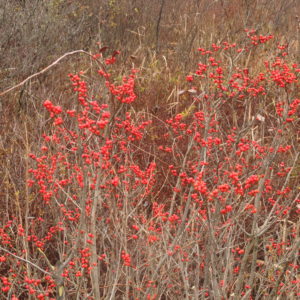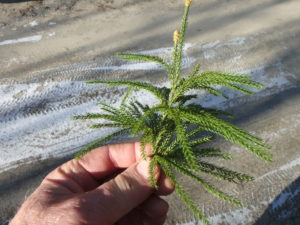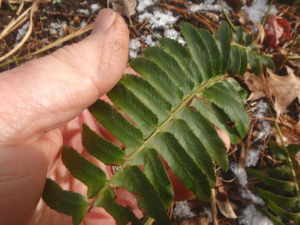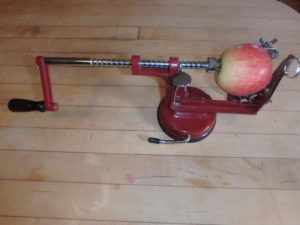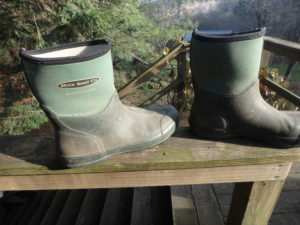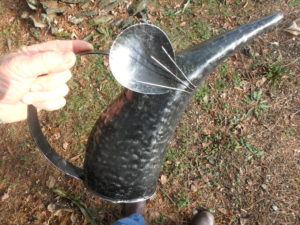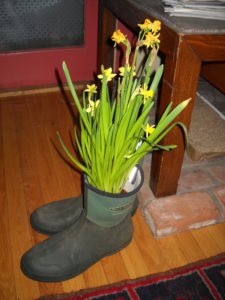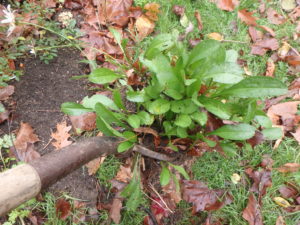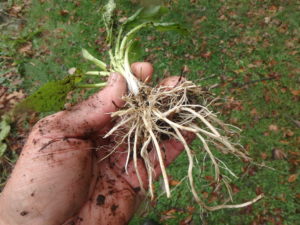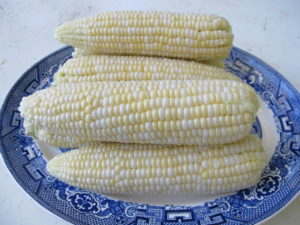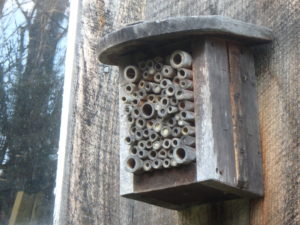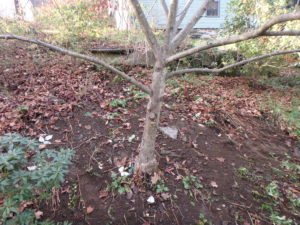Five Plants for Adding Indoor Color
This is the dark time of the year. The sun sets early, and is often obscured by clouds dripping rain and snow. For that reason, I string bright lights on trees outdoors, decorate a tree indoors, place candles in my windows – and lots more. I buy cut flowers, too, but I can’t afford to buy armloads of bright flowers every week. Fortunately the outdoors provides me with many nice things to brighten my living space.
One of my favorite shrubs at this time of year is winterberry (Ilex verticillata). You may have seen the bright red berries of wild winterberry growing alongside the road in wet places, often in standing water. It favors wet places, but can be grown in the average garden. In the wild it is an understory shrub, one that grows in partial shade. It produces the most berries, however, in full sun.
As a landscape plant, the winterberry is best in fall and winter when the red berries are prominent. The spring blossoms are small and white, and hardly noticeable. These shrubs are either male or female, and you need one male for every 6 to 10 females within about a 50-foot range. So when you buy winterberry, plan on having several. Unlike puppies, you can’t lift a tail and know what sex you are buying, but have to depend on the nursery to label them properly.
When you bring cut branches into the house and place them in a vase of water you will notice that they regularly drop berries. There is a solution: spray with a clear lacquer. Last year I sprayed branches that I used on my door wreath, and for the first time ever, most berries stayed on until I took down the wreath. Previously some of the berries fell off every time the door was closed.
Evergreen boughs are commonly used for indoor arrangements, sprays, kissing balls and garlands. If you plan to harvest evergreen branches on your own property for this, be sure to use branches that will hold onto their needles. Balsam fir and spruce, commonly used for Christmas trees, hold onto their needles well even when not in a vase of water. But most of us don’t want to cut off branches if we have balsam or spruce on the property.
What most of us have growing in our woods are white pine and Canadian hemlock. White pines hold their needles, hemlocks do not. The hemlocks have short needles arranged flat along the stems; they have 2 white stripes on the underneath side of each needle. White pine needles are long and pointy, but soft. They grow in bundles of 5 needles (one for each letter in the word ‘white’).
Of the ferns you might see in the woods now, only the Christmas fern (Polystichum acrostichoides) is suitable for use in a vase. These have leathery green leaves with leaflets arranged in an alternating pattern. Some think the leaflets resemble a Christmas stocking, with a toe or heel at the end near its attachment point. I do not. I think they are called Christmas fern because they are still nice at Christmas and other ferns have largely disappeared by now.
Christmas ferns grow in shade or partial shade, and prefer somewhat moist locations. If you pick some, do not completely defoliate an individual plant. Take a few stems from one, and then a few from others. These plants are tough, but slow-growing.
What else is green and will do well indoors? Ground pine (Lycopodium obscurum) grows in deciduous forest in many of the same places as Christmas ferns. It is not a pine at all, but a club moss, a group of primitive plants that fed the dinosaurs when club mosses got to be 30 feet tall. These poor relatives only grow a few inches to a foot tall, but have handsome foliage in winter. They spread by rhizomes or roots. Each plant has leaves that come from the central spine of the plant, and lie parallel to the ground – like little Christmas trees. Please be judicious in picking these.
Back to the reds: red-twigged or redosier dogwood (Cornus sericea), a native of moist areas here in the Northeast, looks good in a vase. The color brightens up considerably in the winter, especially on this year’s growth. If the town road crew brush-hogged the roadside this summer, the new growth on red dogwood will be very bright.
Of course the plant nursery business has been working hard and breeding the reddest, brightest varieties and touting each of them as the very best. But all are good, and are very fast growing – especially in wet areas. I favor pruning out at least half the stems each year to get new stems with bright winter color, and have been known to cut a bush right to the ground.
So don’t feel bad if you can’t afford big vases of roses at this time of year. Get outside and pick some nice things that will brighten the house.
Read Henry’s blog at https://dailyuv.com/
Holiday Gifts for the Gardener
By the time you read this, Black Friday will have passed us by. I know that some people stand in line that day, starting before the sun comes up to get special deals on electronic games and various widgets, but I have never done so. And won’t. My love ones get good, practical presents that will last. Here are my ideas for gardeners to give – or get.
Actually, not all my presents will last. Some are edible presents. Each year, for example, I dehydrate cherry tomatoes, apples, pears and hot peppers. A pint bag of dried cherry tomatoes represents a lot of work – and love. First I had to start the seeds and raise the seedlings. Then plant, stake and weed the plants. Harvest when ripe, cut in half, dry for 18 hours or more, and then bag them up. A pint of these babies is about 240 dried cherry tomato halves. A delectable gift.
Dried apples and pears are easier presents. I have a kitchen tool that will peel, core and slice apples and pears. You skewer the apple, turn a crank, and it’s ready to use in a jiffy. Much less time consuming than cutting cherry tomatoes in half and arranging on a tray. And of course, a few dried apples will fill up a quart bag, and a good tree will last a lifetime. The slicer I have is called the Triple-Action Apple Machine and it’s available from King Arthur Flour (www.king arthurflour.com) for about $25.
As to the dehydrators, those are serious presents. I have 2 kinds, and like both. The Cadillac of dryers is the Excalibur. Mine has 9 trays, a timer and a thermostat. The hot air blows across the trays, so all dry in equal time. Mine, Model 3926T sells for around $300 (www.excaliburdehydrator.com).
For a more economical price you can get a NESCO American Harvester dehydrator. They come with heat and blowing units either on the top of the bottom of a stack of trays. Those closest to the heat dry first, so you have to keep checking them and moving trays around. But they only cost $130 to $150 from the manufacturer. (www.nesco.com). I like the dehydrator with bottom heat best. But they take longer and use more electricity than the Excalibur (1000 watts per hour of use versus 660 watts per hour for the Excalibur).
I spend a lot of time working outside when the grass is wet or paths are muddy. I like dry feet, and nothing compares with my Muck brand boots. I’ve had them for over 10 years, wear them nearly every day in spring and fall, and they are not even thinking of wearing out. Mine are 10 inch high slip-ons, green, insulated. Warm. Looking on line, I think it is called the scrub boot. They cost $60-70 a pair. Of course I bought mine on sale for less.
At this time of year I’m battling mice and squirrels that want to get in the house to find food and lodging. My old house has a stone foundation, so it lets them in, here and there. Recently I got something called, “Mice Magic” from Gardeners Supply (www.gardeners.com) which claims to repel them – avoiding the need for trapping them.
Mice Magic comes in sachets like tea bags that are very fragrant – with spearmint and peppermint. Each lasts, it says, for 30 days. And one only needs one in a room to discourage the mice. So I have them in my basement and in the attic storage areas that tend to accumulate rodents. So far, they seem to be doing a good job, and these would be good presents. A box of a dozen (item # # 8592441) costs $29.95.
Speaking of mice, I recently got a watering can shaped like a mouse – complete with ears and whiskers! This is a metal watering can for indoor plants that makes me smile every time I use it. It pours nicely and holds a nice amount of water. Available from Gardeners Supply for $19.99. (item # 38-315)
Every Christmas when I write this column I mention tools, including the CobraHead weeder. This is, simply, the best weeder in America. It’s a single-tined weeder shaped like a bent finger – or a rising cobra. It can get under weeds and grasses, and tease them out. Available at garden centers everywhere and most seed companies, it is also available on line at www.CobraHead.com for $24.95.
Other tools I’d recommend? A collapsible rake. These can be adjusted to open widely, to 24 inches, or closed down to just 8 to 12 inches. There are several brands, and prices range from under $10 to about $25. All metal.
Books are great for gardeners, too. This fall I attended a lecture by Thomas Rainer and bought his book, Planting in a Post-Wild World: Designing Plant Communities for Resilient Landscapes, co-authored by Claudia West. It’s an interesting read, presents many provocative ideas, particularly for urban and suburban gardeners. They explain, for example, that we often plant gardens with plants that would never be together in the wild – they have entirely different needs for sun, water, pH – and we could do better planting those that have similar requirements. (Timber Press, $39.95).
Last winter I attended a talk by Celeste Longacre and bought her self-published book, Celeste’s Garden Delights: Discover the Many Ways a Garden Can Nurture You (available for $25 at www.celestelongacre.com). It’s a nice book that not only gives tips for growing vegetables, but also for storing and using them. I got some good tips from it, including a better way to store beets.
So Santa, I don’t really need anything this Christmas, but if you want to drop off a load of reindeer droppings, they’d be great for my compost pile.
You may reach Henry at henry.homeyer@comcast.net or by mail at PO Box 364, Cornish Flat, NH 93746. Please include a SASE if you want a response by mail. Read his blog at https://dailyuv.com/gardeningg
Forcing Bulbs
Each fall I pot up daffodils, tulips, crocus and other bulbs for indoor blooming. Now is the time to do it. It takes a long time for bulbs to establish roots and get ready to bloom, come spring, so the sooner you do so the better. Most bulbs need three to four months before they are ready.
Most bulb packages will specify early, mid-season or late blooming times. When selecting bulbs for forcing, choose early-blooming or mid-season varieties. Species tulips like Fosteriana and Kaufmanniana are both early. The Darwin hybrids are early- to mid-season varieties that force well. Triumph tulips are also good.
Of the early daffodils my favorite is Tete-a-Tete which produces small gold flowers, 2 or 3 blossoms per bulb. These are readily available in grocery stores in early spring and I buy them already blooming in small pots for under $5. One of my favorite things to do with them is to put a pot in a rubber boot in the mudroom, their blossoms poking out of the boot. It always evokes a reaction from visitors.
So how do you force bulbs? Plant them in ordinary potting soil in pots and keep them in a cool spot that stays slightly above freezing, and never more than 50 degrees. I have a cold, above-ground basement that is perfect for that. But you can keep them in the garage or perhaps the bulkhead.
No harm is done if temperatures drop below freezing for part of the time they are getting ready, but no growth occurs when they are frozen, so keeping them above freezing is better.
Bulbs have everything they need to bloom already packaged inside. You don’t need to fertilize the bulbs when you plant. Each fall I clean out all the pots that had annual plants on the deck and save the potting mix in a big contractor bag. I use that potting material to fill other pots for forcing bulbs.
Mice can be an issue if planting tulips or crocus, though daffodils and alliums are of no interest to them. I cut squares of plywood large enough to cover any pots I use for tulips. I put a brick on top of the plywood to keep mice out – they can squeeze through incredibly small spaces.
Most gardening books warn against watering the soil mix in which you have planted bulbs. They say bulbs will rot if too wet. That may be true, but I’ve found that in winter my problem has been more with the soil drying out too much. Humidity is very low in winter, and the potting mix, which is peat-based, loses moisture quickly by evaporation. I check the soil once a month and water if the soil feels dry. One year I let the mix dry out to much and did not get many blossoms. Always start with lightly moist soil mix.
Clay pots may look good to you, but they can allow moisture to evaporate quickly from the sides of the pot. Plastic, fiber glass or porcelain containers are better for bulbs because they hold the moisture of the potting mix, minimizing water loss.
So how close can you plant your bulbs? Basically as close as you want. I have some nice Italian pots that I use each year for forcing. They are rectangular, roughly 14 inches long, seven inches wide and six inches deep. I put 8 to 10 bulbs in each one. In a 10-inch round pot I put 10 daffodils. An inch or two between bulbs is fine.
Most pots do not allow the same planting depth you would have outside. Instead of 6 inches of soil covering a tulip or a daffodil, two or three inches is fine. I put a thick layer of soil in the bottom of the pot, then arrange the bulbs on it. I push down on each bulb to set if firmly in place, and then cover with soil mix. A light watering is good after patting the top of the soil to firm it up a bit.
If you do have a deep pot – 10 inches or so – you can plant 2 layers of bulbs. Plant daffodils near the bottom of the pot, add soil mix, and then add some small bulbs like crocus or snowdrops near the soil surface. Just leave a little more space between the small bulbs than you might otherwise so that the daffodils can grow up between them.
How do you know when your bulbs are ready to bring into the warmth of the house? Make a tag for each pot that tells you what is planted, and when it was planted. Eight to twelve weeks is fine for daffodils, and 16 weeks for tulips. But look at the pots. If buds are up and craving light, bring them up a little early if you wish. But never bring tulips up before the end of February or they won’t bloom.
Winter is often a hard time for gardeners. We crave working in the soil and seeing things grow. Forcing bulbs indoors is one way we can satisfy our need to have flowers – even with snow on the ground.
You may reach Henry at PO Box 364, Cornish Flat, NH 03746. Please include a SASE if you want a written reply. Better yet, e-mail him at henry.homeyer@comcast.net. You may read his blog posts at https://dailyuv.com/
Tips for Fall Transplanting
Now is a good time to divide and transplant some of your perennials. I recently dug up and moved Shasta daisies, Siberian iris and snakeroot (Cimicifuga spp). Most perennials can be divided in either spring or fall, and experience is the best way to know what season is best for any given plant. Most plants are not too fussy.
Shasta daisies tend to die out if they are not divided every 3 to 5 years. And you probably have seen iris with a big dead section in the middle of a clump. It’s my belief that the center dies out because the plants have used up all the needed minerals in the soil. This starts in the middle where the original plant began its life.
Why bother digging up and dividing flowers? Some develop into huge clumps that overwhelm a garden bed, or elbow out nice plants next to them. This is particularly true for plants that spread by root like beebalm (Monarda didyma), common orange daylilies and obedient plant (Physostegia virginiana). Those plants can be quite aggressive.
Other plants, heavy-feeders, need to be divided in order to enrich their soil. Once a year I generally sprinkle some slow-release organic fertilizer like Pro-Gro or Garden Tone over Siberian iris to help replenish minerals that get used up. This minimizes the need to divide and re-plant. But digging up and adding compost and fertilizer will help considerably to re-energize a plant.
Here is what I do: I use a garden fork or drain spade (an extra-long spade) to loosen up the roots of a plant by sliding it in under the plant at a 45 degree angle and prying upward. Some plants – daylilies and Siberian iris, for example, hold on tightly. Others, like Shasta daisies and bearded iris have roots near the soil surface and come up easily. You may have to go all around the perimeter with your fork, or just on 2 sides.
I lift the plant out of the ground and place it in a wheelbarrow or on a tarp to minimize soil loss and messiness. Then I use my hands, a shovel or a sharp serrated knife to divide the plant. I like to just split it into several smaller chunks with my hands if possible. But a big chunk of Siberian iris will not pull apart, so cutting through the roots is necessary. I know that seems brutal, but the plant will survive nicely.
If you have invasive weeds or perennials growing near the plant you are dividing, you should be very attentive to the roots. Know the color and texture of goutweed roots, for example. If you see even a smidgen of goutweed root in with the plant you are dividing, STOP! You don’t want to move it to a new area of your garden.
If you are receiving plants from friends, always ask if they have invasives. I got goutweed from a dear friend who kindly gave me some iris – with goutweed roots mixed in. Twenty years later I am still fighting a losing battle with that goutweed.
If you think there might be roots of an invasive plant, either throw it out or bare-root it. Bare-rooting a plant means removing all the soil from the root mass. I do this with a sharp stream of water from my hose. It’s a messy procedure, but getting rid of the soil will allow you to see what roots are part of the plant you want, and what else may be mixed in. Most invasives have distinctive roots.
When you bare-root a plant it is important, when re-planting it, to make sure you get soil to cover all the roots. I will make a hill of soil in the planting hole and drape the roots over it. With my fingers I press soil around the roots, and cover them well. Then I water to get soil to fill in air pockets. Even though air is needed by roots, air pockets will dry out roots, damaging them.
After your plants are lovingly tucked in for the winter, spread some mulch over them. This will slow the soil from freezing, and give the plant more time to establish its roots. I like chopped leaves or pine needles, but chopped bark mulch is fine, too.
When you are cleaning up your flower beds this fall, think about cutting back annual flowers instead of pulling them. If you pull a big sunflower or zinnia, you are leaving an open space that will practically invite weed seeds to infiltrate your garden. If you leave the roots and a little stem, those may decompose over the fall and spring and add organic matter to your soil. And if your flower bed is on a slope, even a gentle one, a bare spot of soil will allow heavy rains to wash off some of your precious topsoil. You can pull those roots when you are ready to plant next spring.
This is also a good time to dig up and get rid of plants that you don’t like, are too aggressive, or are just not thriving. You don’t have to keep every plant. If you don’t like it, get rid of it!
Cold weather is on the way, so if you need to divide plants, you’d better get going!
You may reach Henry at henry.homeyer@comcast.net or by mail at PO Box 364, Cornish Flat, NH 93746. Please include a SASE if you want a response by mail.



